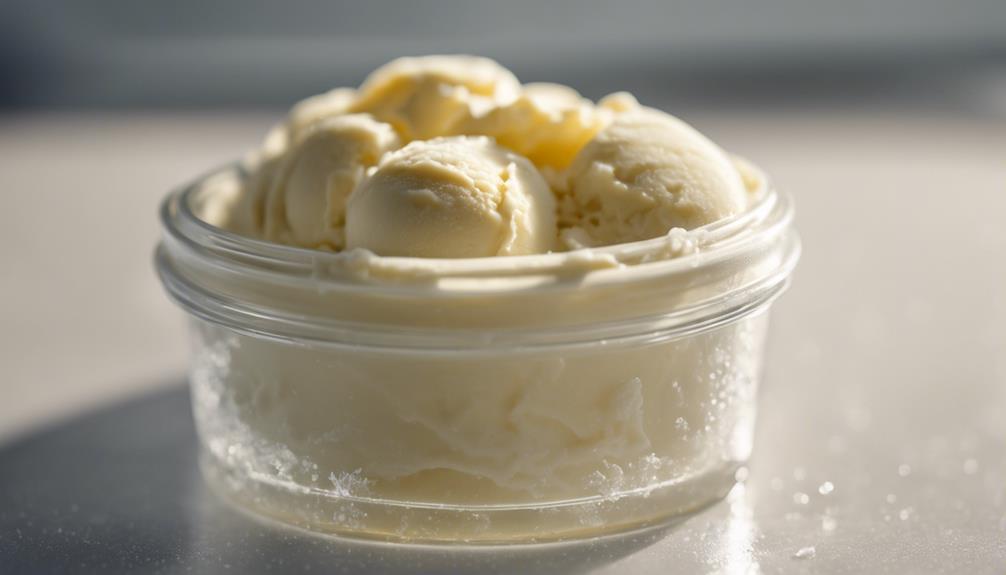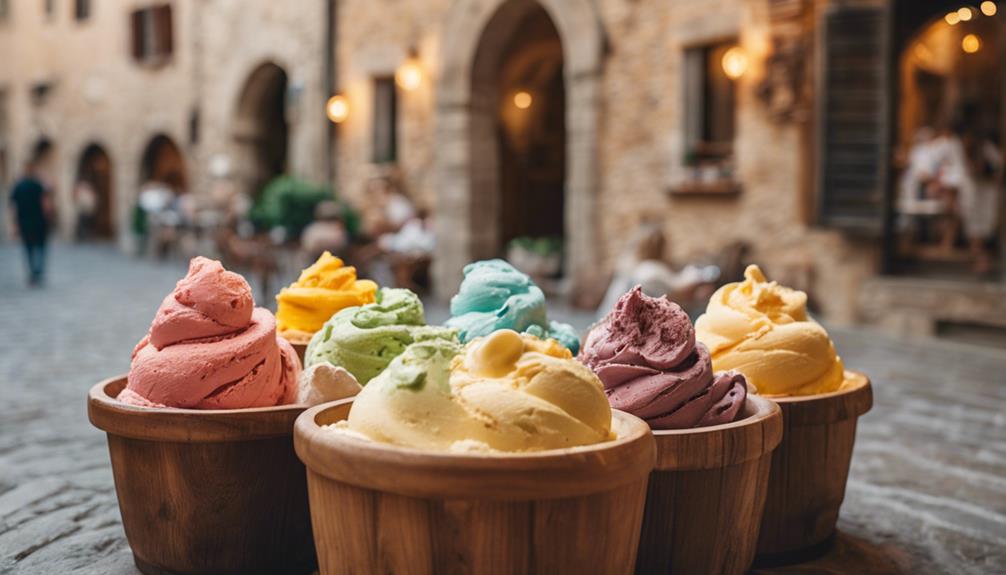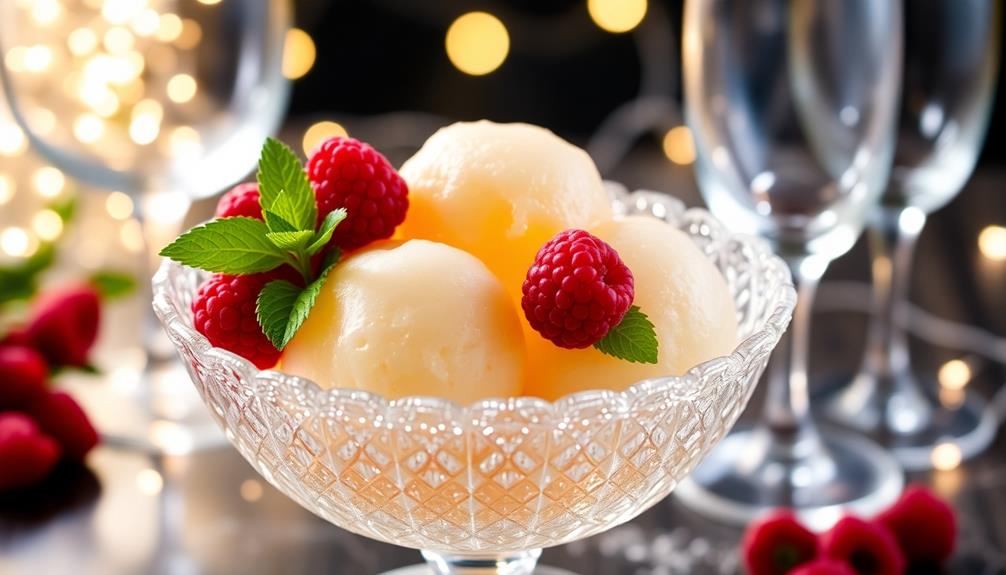For the richest and most indulgent vanilla ice cream, adding eggs is essential. The custard base with eggs provides a creamy texture and decadent taste. Don’t overlook the luxurious result eggs bring. Personalize with mix-ins and flavor options to create a unique treat. Try out various flavors other than vanilla for distinct frozen desserts. Taking care to store the custard base properly extends its shelf life. Share and adjust the recipe for a collaborative cooking experience. Enjoy the richness and flavor complexity that egg-enhanced vanilla brings to create a truly indulgent dessert.
Key Takeaways
- Incorporating egg yolks creates a rich custard base for ultimate creaminess.
- The ideal egg-to-milk ratio enhances flavor depth and luxurious texture.
- Tempering eggs prevents curdling and ensures a velvety smoothness.
- Experiment with different numbers of yolks for varying levels of richness.
- Egg-enhanced vanilla ice cream surpasses store-bought options in flavor and creaminess.
Vanilla Ice Cream Recipe Details

Creating a rich and creamy vanilla ice cream involves mastering the classic custard base with eggs. This homemade recipe is all about achieving that decadent and luscious texture that makes your taste buds sing with delight.
By incorporating eggs into the custard base, you're adding a luxurious richness that sets this vanilla ice cream apart from the rest. The heavy cream plays a pivotal role in ensuring that your ice cream turns out creamy and velvety, making each bite a delightful experience.
When making your own vanilla ice cream, don't shy away from using eggs in the custard base. While eggless versions exist, they may not provide the same creamy texture and depth of flavor that a custard-based recipe offers.
To truly elevate your homemade vanilla ice cream to a decadent treat, embrace the classic method of creating a custard base with eggs for a dessert that's sure to impress.
Recipe Yield and Variations

To adjust the yield of the vanilla ice cream recipe or explore various flavor variations, consider the recipe's adaptability and the potential for customizing your frozen dessert experience.
The vanilla custard-based recipe makes 1 quart of delicious ice cream, perfect for a quart ice cream maker. If you have a larger 2-quart machine, simply double the ingredients for a bigger batch. This egg custard base guarantees a creamy texture and richness that sets well when frozen.
Experiment with different mix-ins like Oreos or try a Porto substitution for added flavor complexity. The recipe allows for easy customization, so feel free to multiply the ingredients for larger gatherings or to suit your preferences.
Whether you prefer a classic vanilla base or want to explore different flavors, this versatile recipe provides a solid foundation for creating your own personalized ice cream variations.
Additional Ice Cream Recipes

Now, let's discuss creating some invigorating ice cream flavors to expand your dessert repertoire.
From decadent chocolate to rejuvenating mint chocolate chip, the possibilities are endless for your culinary experiments.
Get ready to share and swap recipes with fellow ice cream enthusiasts for a fun and flavorful experience in the kitchen.
Flavorful Ice Cream Variations
Explore a delightful array of ice cream flavors beyond vanilla, including chocolate, mint chocolate chip, butter pecan, and blueberry cheesecake. When it comes to homemade ice cream, the possibilities are endless for creating unique and delicious frozen treats. Experimenting with different ice cream flavors allows you to cater to various preferences and cravings. Whether you prefer the classic taste of old-fashioned vanilla ice cream or the richness of custard ice cream made with egg yolks, there is a flavor for everyone to enjoy.
To showcase the diversity of ice cream flavors, here is a table highlighting some popular options:
| Flavor | Description | Key Ingredients |
|---|---|---|
| Chocolate | Rich and indulgent cocoa flavor | Cocoa powder, cream |
| Mint Chocolate Chip | Invigorating mint with chocolate chips | Mint extract, chocolate |
| Butter Pecan | Buttery and nutty goodness | Pecans, butter, cream |
| Blueberry Cheesecake | Creamy cheesecake with blueberry swirls | Blueberries, cream cheese |
Get creative with your ice cream making and have fun exploring these flavorful variations!
Community Ice Cream Creations
Engage with fellow ice cream enthusiasts to explore a variety of additional homemade ice cream recipes, including Cookies N Cream, Chocolate, and custom flavors. In the vibrant ice cream community, you can find inspiration for creating gluten-free frozen treats and experimenting with innovative flavors. Share your own unique recipes and variations with like-minded individuals using #yesalyonascooking on Instagram and Pinterest to showcase your delicious creations.
Homemade ice cream opens up a world of possibilities beyond traditional vanilla. Explore the endless creativity within the community, where individuals are constantly pushing the boundaries of flavor and texture. Whether you prefer classic recipes like Cookies N Cream or want to dive into rich Chocolate creations, there's something for everyone in this diverse and welcoming space.
Custard Base Storage and Freezer Shelf Life

You should take note of the recommended storage durations and methods for custard bases when preparing homemade ice cream.
It's pivotal to keep your ice cream in an airtight container to preserve its flavor and texture.
Storage Recommendations
For best results, the custard base for vanilla ice cream should be refrigerated for 3-4 days before churning. Once you have churned your homemade vanilla ice cream, proper storage is key to maintaining its delicious texture. It is recommended to store the finished ice cream in an airtight container to prevent ice crystals from forming. Placing a layer of plastic wrap directly on the surface of the ice cream before sealing the container can further help in preventing freezer burn.
To emphasize the importance of proper storage methods, here is a helpful table outlining some key storage recommendations for your vanilla ice cream:
| Storage Method | Recommendation |
|---|---|
| Refrigeration | 3-4 days before churning |
| Freezer | Up to 2 months in an airtight container |
| Homemade Ice Cream Texture | Maintain by using plastic wrap directly on the surface |
Freezing Guidelines
After refrigerating the custard base for 3-4 days before churning, the next step is to follow appropriate freezing guidelines for storing your homemade vanilla ice cream.
Once the mixture is churned into a creamy ice cream, transfer it into an airtight container. Make sure the ice cream is stored in the coldest part of the freezer to maintain its texture and flavor. Before sealing the container, cover the surface of the ice cream with plastic wrap to prevent the formation of ice crystals.
Whether you have made your ice cream from scratch or bought it from the store, storing it correctly is essential. Homemade ice cream can last up to 2 months in the freezer without compromising its quality if stored properly.
Community Interactions and Recipe Adaptations

In community discussions surrounding this vanilla ice cream recipe, various experiences with ice cream making methods and flavor adaptations are shared among enthusiasts. Users engage in conversations about perfecting vanilla ice cream, experimenting with flavors, and creating unique flavor combinations. They exchange tips on making ice cream without a churn and storing the custard base for best results.
Readers often request ingredient amounts and variations to tailor the recipe to their preferences, showcasing a shared passion for homemade ice cream within the community. Feedback highlights successful attempts at adapting the vanilla ice cream recipe, such as incorporating Oreos or experimenting with strawberry ice cream variations.
The interactions demonstrate a collaborative effort to enhance the recipe and explore new ways to enjoy delicious frozen treats. Participants in these discussions inspire one another to push the boundaries of traditional vanilla ice cream by embracing creativity and innovation in their culinary endeavors.
Recipe Benefits and Reviews

Enhance your ice cream experience with the rich and creamy texture of homemade vanilla ice cream made with eggs. The addition of egg yolks in the churning method results in a light and fluffy consistency, elevating the dessert to a decadent level. The use of egg yolks not only enhances the creamy texture but also brings out a rich flavor that surpasses store-bought options. The versatile nature of this vanilla ice cream recipe allows for a more pronounced vanilla taste, making it a go-to choice for dessert lovers.
Readers have raved about the egg-enhanced vanilla ice cream recipe, praising its superior taste and luxurious mouthfeel. The combination of egg yolks with the churning process creates a velvety smoothness that sets this homemade vanilla ice cream apart. The recipe's ability to deliver a creamy and rich flavor profile has made it a favorite for those seeking a truly indulgent treat.
Ingredients and Cooking Process

Let's now move on to exploring the ingredients and cooking process for preparing this delectable vanilla ice cream recipe with eggs. The main ingredients you will need for this best homemade vanilla ice cream recipe are eggs, sugar, milk, heavy cream, vanilla extract, and a pinch of salt. To start, you will need to combine the eggs and sugar in a bowl and whisk until they become pale and creamy. Then, heat the milk in a saucepan until it is steaming but not boiling, and slowly pour it into the egg and sugar mixture, whisking constantly. This will temper the eggs and prevent them from curdling. Finally, add the heavy cream, vanilla extract, and salt, and churn the mixture in an ice cream maker until it reaches the desired consistency.
Egg yolks play a vital role in creating a rich and creamy custard base for the ice cream. The ideal ratio of egg yolks to dairy is typically four yolks to three cups of milk and cream, resulting in a decadent texture. More yolks contribute to a richer and creamier ice cream, while fewer yolks lead to a lighter consistency.
The egg yolks not only thicken the base but also enhance its taste and texture, providing a smooth finish. To make sure the eggs blend smoothly without curdling, it's necessary to temper them. This process involves slowly mixing hot milk into the egg-sugar mixture to raise the temperature gradually.
Frequently Asked Questions
What Does Adding Eggs to Ice Cream Do?
Adding eggs to ice cream creates a rich and creamy custard base. Egg yolks thicken the mixture, contributing to a smoother texture. The fats in yolks enhance mouthfeel and richness, while also helping emulsify ingredients for a smooth consistency.
What Is the Role of Eggs in Quality Vanilla Ice Cream?
Eggs elevate vanilla ice cream, delivering a creamy texture and rich flavor. With emulsifying properties, yolks bind ingredients for a silky consistency. More yolks mean denser, custard-like ice cream. Their fat content creates a luxurious mouthfeel, thickening the base for a velvety finish.
Does Vanilla Ice Cream Have Eggs in It?
Vanilla ice cream often contains eggs for a rich, creamy texture. The yolks create a custard base that thickens the mixture, leading to a velvety consistency. Eggs contribute to a smoother mouthfeel and luxurious taste.
How to Make the Creamiest Ice Cream?
To make the creamiest ice cream, whisk egg yolks into the base for a velvety texture. Tempering eggs properly avoids curdling, giving you a smooth custard. Add richness and depth, creating a luxurious mouthfeel. Try it for the ultimate treat!
Conclusion
Indulge in the creamy goodness of homemade egg-enhanced vanilla ice cream, perfect for satisfying your sweet tooth cravings.
This recipe is like a scoop of sunshine on a hot summer day, bringing a burst of flavor and nostalgia with every bite.
So grab a spoon, dig in, and treat yourself to a taste of pure ice cream bliss!









